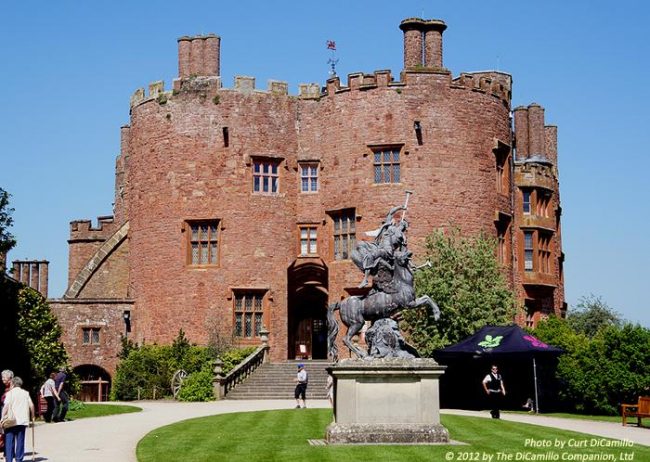
The Entrance Facade
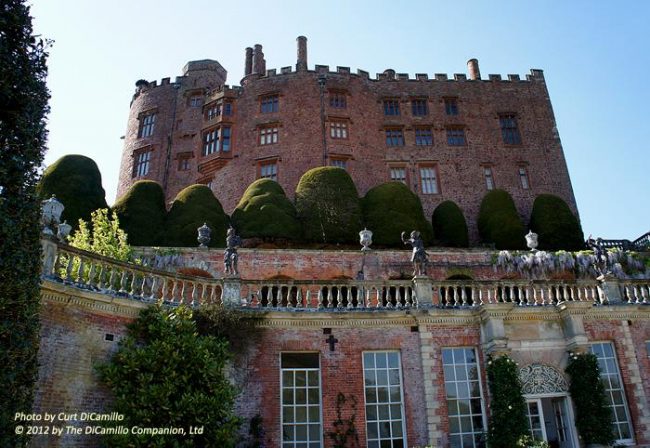
House from the Terrace Garden
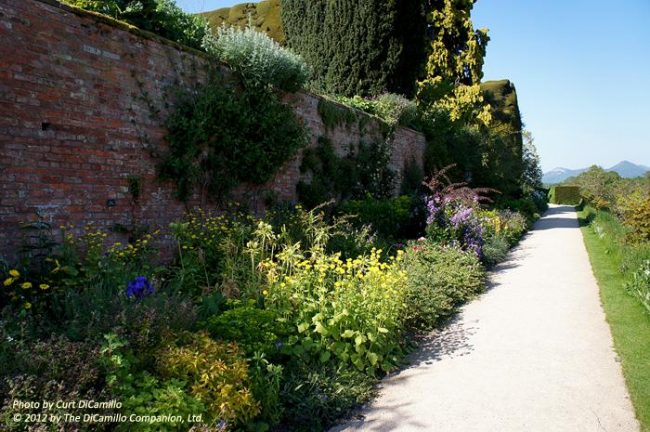
The Terrace Garden
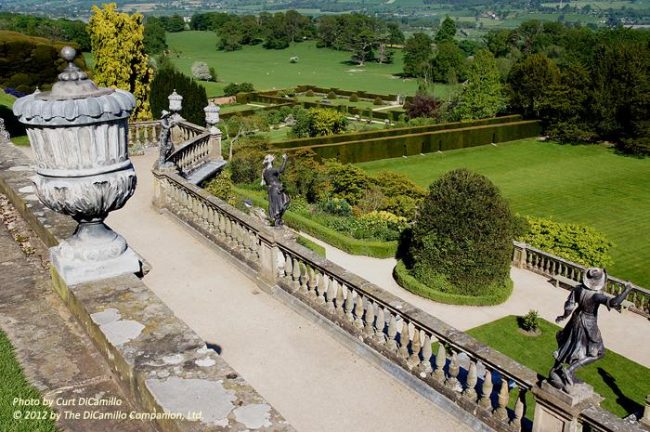
The Terrace Garden
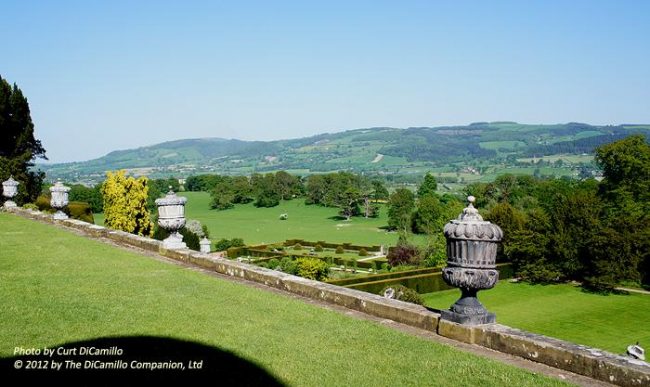
View from the Terrace Garden
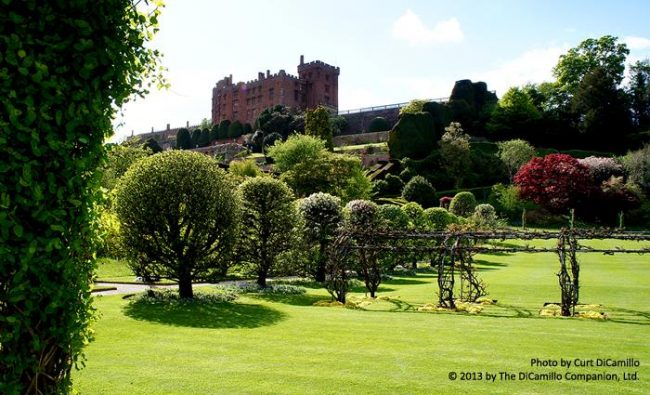
The Castle from the Lower Garden
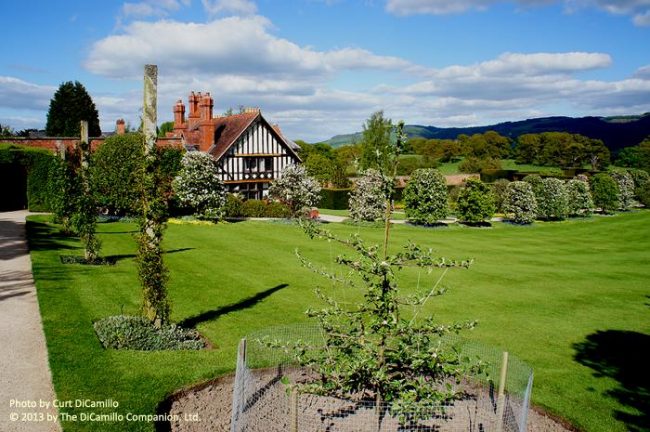
The Lower Garden
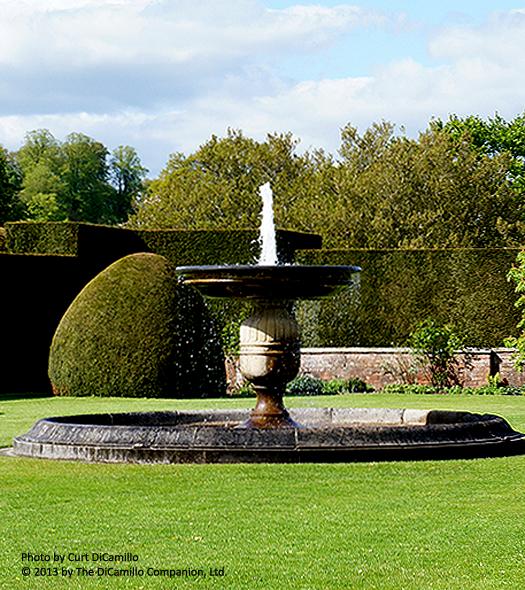
The Fountain in the Lower Garden
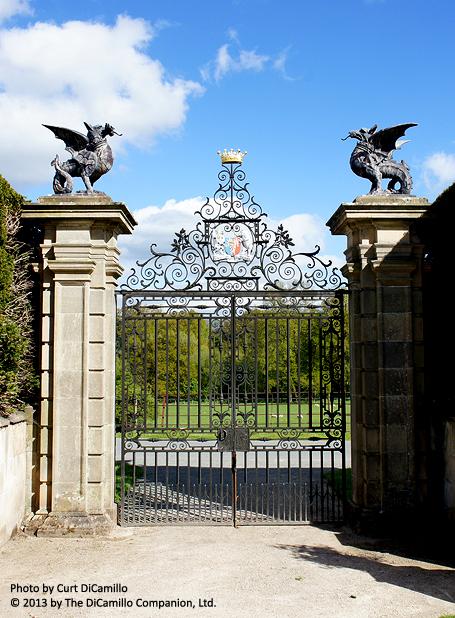
The Bodley Gates in the Lower Garden
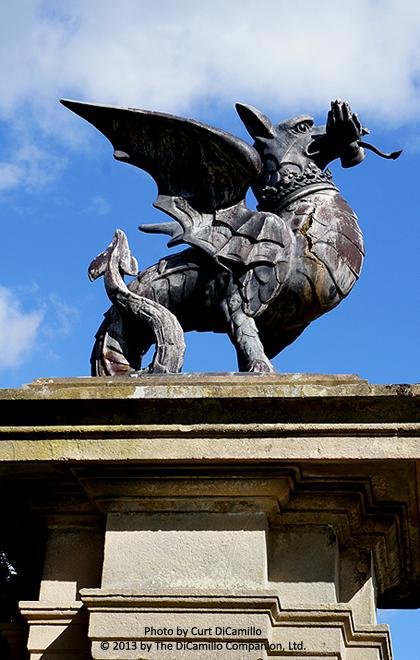
Welsh Dragon on the Bodley Gates, Powis Castle | Photo by Curt DiCamillo
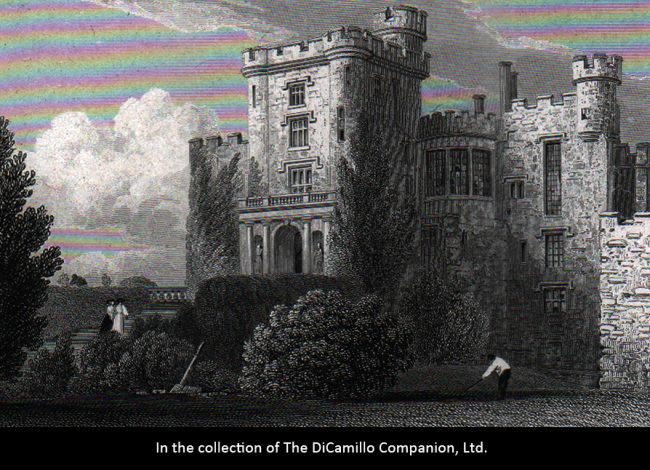
The Entrance Facade from an 1829 engraving from "Neale's Views of Seats"
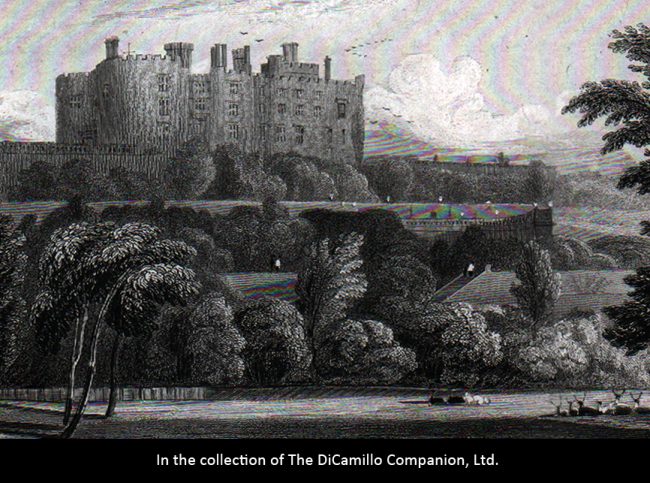
The House from the garden from an 1829 engraving from "Neale's Views of Seats"
Built / Designed For: Powis was originally built circa 1200 for Welsh princes.
House & Family History: Originally built by Welsh princes, Powis Castle resides high above the town of Welshpool, protected from the market town by a great wooded landscaped park. There has been a castle or fortress on the site since at least 1196. During medieval times Powis was known as Pool, Poole, or Pole Castle. Locally it was also known by the names Red Castle or Castell Coch (coch is red in Welsh) because of the red stone from which the Castle is built. In 1587 Powis was sold to Sir Edward Herbert, the second son of William Herbert, the 1st Earl of Pembroke (Sir Edward's mother was Anne Parr, sister of Catherine Parr, 6th wife of Henry VIII); it was Sir Edward who transformed the fortified castle into to a Baroque palace. Sir Edward's wife was Catholic and their children were raised in the Roman faith. In October of 1644 the Castle was captured by Parliamentary troops (the Herberts were supporters of the king) and not returned to the family until the restoration of Charles II in 1660. The 3rd Lord Powis (created Earl Powis in 1674 and Marquess of Powis in 1685) was one of James II's chief ministers and followed him into exile in 1688. This Lord Powis had the interiors of the House fitted out, probably by William Winde, in the 1660s-1680s. In 1748 the Castle was inherited by Henry Arthur Herbert, a Protestant, who was created 1st Earl of Powis by George II, the earlier titles of earl powis and marquess of Powis having become extinct when the 3rd Marquess of Powis died unmarried in 1748. Lady Henrietta Herbert, daughter of the 1st Earl of Powis, married Edward Clive in 1784. Clive was the son of the famous Robert Clive (Clive of India) and brought new wealth to the depleted estates of Powis. The Clive Museum at the Castle displays myriad Indian treasures brought back by Clive of India and his son, including a tiger's head from the rail of Tipu Sultan's throne. Powis contains one of the finest collections of paintings and furniture in Wales, one of the stars of which is the brilliant, large ceiling canvas by Antonia Verrio on the Grand Staircase. The Tudor Long Gallery (the only surviving Elizabethan interior dating from Sir Edward Herbert's acquisition of the Castle in 1587), studded with classical sculpture, has been called one of the most romantic rooms in Britain. The State Bedroom, circa 1661, is the only surviving bedroom in Britain where the balustrade rails off the state bed (canopied 18th century mahogany) in its alcove in the royal French style. In 1952 the Castle and garden were given to the National Trust by the 4th Earl of Powis. (We are grateful to Gareth Williams for his contributions to this history of Powis Castle.)
Collections: Powis contains one of the finest collections of paintings and furniture in Wales. A tiger's head from the rail of Tipu Sultan's throne and Tipu's shoes and sword are part of the booty of Clive of India on display in the Clive Museum at the Castle. Bernardo Belloto's "View of Verona" was sold in 1981 for £160,000 to remain on site. Nicolas Poussin's "The Finding of Moses" was a shared purchase by The National Gallery (London) and The National Museum of Wales. The 19th century state coach and livery, the finest in the ownership of the National Trust, is on display in the Coach House.
Comments: "(Powis's) grand situation, its charming and magnificent Prospects, its extensive woody Parks of many hundred acres...render it one of the first Seats in the Kingdom." -Sir John Cullum, 1774. The Long Gallery is frequently called one of the most romantic rooms in Britain.
Garden & Outbuildings: Powis is world famous for its terraced gardens, probably designed by William Winde in the 1680s. Overhung with enormous clipped yews, the garden still has its original van Nost lead statues, an Orangery, and an Aviary on the Terraces. Much of this was laid out under French and Italian stylistic influences. In the 18th century an informal woodland wilderness was created. Sir Richard Colt Hoare wrote in 1806 that Powis had the potential to be "a Villa D'Este in miniature." The Castle once had a smaller version of the Chatsworth Cascade; sadly, no traces remain of this water garden today. The Castle is today surrounded by a medieval Deer Park with massive oaks that may be as much as 800 years old. An Edwardian Dower House is extant on the Estate. Starting in 1911, Violet, wife of the 4th Earl, started the repair and restoration of the gardens; the look she created is what is seen in the gardens today.
Architect: William Winde (Wynne)
Date: 1670s-1680sArchitect: Thomas Farnolls Pritchard
Date: 1775-77Architect: William Baker
Date: 1748-54Architect: George Frederick Bodley
Date: 1902-04John Preston (J.P.) Neale, published under the title of Views of the Seats of Noblemen and Gentlemen in England, Wales, Scotland, and Ireland, among other titles: 2.S. Vol. V, 1829.
Country Life: XXIII, 666, 1908. XLI, 108 plan, 132, 1917. LXXIX, 598, 624 plan, 652, 1936.
Title: English Country House: A Tapestry of Ages, The
Author: Maroon, Fred J.
Year Published: 1987
Reference: pg. 97
Publisher: Virginia: Thomasson-Grant
ISBN: 0934738254
Book Type: Hardback
Title: Debrett's Peerage and Baronetage, 1990
Author: Kidd, Charles; Williamson, David (Editors)
Year Published: 1990
Reference: pg. P 995
Publisher: London: Debrett's Peerage Limited (New York: St. Martin's Press, Inc.)
ISBN: 0312046405
Book Type: Hardback
Title: Disintegration of a Heritage: Country Houses and their Collections, 1979-1992, The
Author: Sayer, Michael
Year Published: 1993
Publisher: Norfolk: Michael Russell (Publishing)
ISBN: 0859551970
Book Type: Hardback
Title: Biographical Dictionary of British Architects, 1600-1840, A - SOFTBACK
Author: Colvin, Howard
Year Published: 1995
Reference: pgs. 94, 784, 880
Publisher: New Haven: Yale University Press
ISBN: 0300072074
Book Type: Softback
House Listed: Grade I
Park Listed: Grade I
Current Seat / Home of: John George Herbert, 8th Earl of Powis.
Past Seat / Home of: Edward Herbert, Viscount Clive, 19th century.
Current Ownership Type: The National Trust
Primary Current Ownership Use: Visitor Attraction
Ownership Details: The current Earl of Powis lives in part of the Castle.
House Open to Public: Yes
Phone: 01938-551-929
Fax: 01938-554-336
Email: [email protected]
Website: https://www.nationaltrust.org.uk
Awards: Regional Winner of the NPI National Heritage Award 1999/2000
Historic Houses Member: No